Abstract
The development of information and communication technologies, the definition of the content and direction of current policy in education, the formation of feedback channels with students - all these are the ways to increase the effectiveness of modern higher education. The partial transition of universities to the online environment is the challenge of our time. On the one hand, modern communications provide new opportunities for interaction between teachers and students. On the other hand, face the formalism and unwillingness (technical, moral, etc.) of their full application. The research aims to analyze the current state and potential of online communication between teachers and students in the higher education system. The article discusses the features of the use of new communication technologies in university teachers' activities in the interaction with students. The possibilities of modern means of communication for effective cooperation and implementation of the educational process are investigated. The problems and possibilities of using online education in crises are considered. The readiness of teachers to interact with students through modern communication technologies is analyzed. The satisfaction of students and teachers with online interaction and distance education is revealed using survey methods. The conclusions outline the problem and promising aspects of modern online communications, their impact on increasing distance education efficiency, and predicting possible options for its further use.
Keywords:
Introduction
The integration of online communication into the modern public space as a process of information exchange using modern information and communication technologies leads to qualitative changes in various spheres. Digitalization transforms the way individuals interact with each other, forms new industries and areas of activity, leads to profound changes in fundamental social institutions, particularly in higher education institutions.
The institute of education is forced to become more and more involved in the information environment, that, first of all, is expressed in the introduction of online forms of learning as a new element of its development.
Online education around the world has moved forward significantly on the background of the unexpected and rapid changes occurring in this year
Since the late 1990s, when the Internet began to play a more or less prominent role in education, universities have gradually begun to use this innovative technology and change strategic priorities increasingly. Online learning proved convenient for working adults and is recognized by the millennial generation. Universities began to use online communication to enrich the content of the curriculum and attract new students. The legitimacy of online education is strengthening as new needs arise among representatives of target groups and it has already irrevocably entered our lives (Amemado, 2020).
Problem Statement
The online format is particularly relevant nowadays since the current international situation connected with COVID-19 virus spread on the territory of almost the entire world. It leads to adjustments and affects all aspects of the social life and in particular the educational process, its features and the format of interaction: teacher-student.
Nonetheless, despite the active development and appearance of various educational online platforms, digitalization of higher education has started relatively recently interfering traditional practices of modern universities' students and teachers. The strength of classical Russian education has always been its fundamental nature: that is, the orientation to the scientific nature, completeness and depth of theoretical knowledge. Fundamental bases change relatively slowly. At the same time applied, practice-oriented side of the educational process related to the technological basis of the profession being studied has always changed faster (Serditova & Belotserkovskii, 2020). The ideal combination of the modern higher education should be to preserve the fundamental nature and consider technological changes.
Recently the fragmentary character of online learning on the basis of the institute of the higher education remains. It is mainly determined by the heterogeneity of the academic environment regarding the mastering of online technologies. The leading universities of the country (MSU, HSE, RANEPA, and others) consider mass online courses as a part of the educational system that has consolidated its meaning for students to receive comprehensive education. The regional universities, that are only now beginning to implement information technologies, are significantly lagging, this, in general, leads to the assessment of Russian higher education market as a market which content is mainly classical, rather than innovative.
The usage of MOOC to implement the educational programs (Roshchina et al., 2018) gave universities the opportunity to expand the educational choice provided to students and created conditions for virtual academic mobility (Bystrova et al., 2018), increasing of availability of education, and reducing the cost of educational services (Larionova & Tretyakov, 2016).
Analysis of the current MOOC market shows an intensive growth in the number of MOOC manufacturers and providers, as well as an increase in the number of online course participants. Millions of people around the world are in need of highly-quality affordable education and search for the opportunities of professional and personal growth, that is why the world’s leading countries are actively developing online education. Placing MOOC of Russian universities in a foreign language in international MOOC market will allow Russia to solve a number of cultural, political and economic problems. International platforms can be considered as means to promote their own culture, as an opportunity to draw attention to their history, modern scientific and technical developments (Semenova et al., 2018).
The leading Russian universities have been experimenting with distance educational technologies for a long time, this prosses is usually limited to open online courses on both their own and open platforms and created mainly to attract applicants rather than teach students. However, at the same time, metropolitan universities do not see organizational obstacles for transferring a great number of students to distance learning considering their experience of remote working to provide quality support for both the teacher and the student during the educational process.
Critics of massive education rightfully point out that speaking of online courses the percentage of complete courses is relatively low: based on the results of one study – 4%, although this figure increases when students pay for the use of advanced educational opportunities or the certificates (Zakharova, 2019).
Research Questions
Though the development trends of the online learning and its perspectives undergoing significant changes, which is connected with a new world phenomenon – the spreading of coronavirus, forcing countries to switch to online formats regardless of the degree of their readiness for this process of technical and organizational elements of universities
Purpose of the Study
To identify opportunities and limitations of online communication between teachers and students in higher education in modern conditions.
Research Methods
The authors of the article conducted a research that examined the features of distance teaching during self-isolation. 400 university teachers living on the territory of the Russian Federation were interviewed using an online questionnaire. The respondents come from 50 cities and more than 70 universities. The quota sample has three bases: gender, age, and position at the university. The research was conducted in May 2020, when teachers have already adapted to existing situation and the first negative emotions were experienced.
Additionally, an internet survey was conducted among 202 university students in Yekaterinburg that examined their online education view.
Findings
The first limitations of online communication which were faced by teachers and students during self-isolation are material and technical equipment of the workplace. Only a quarter of the teachers surveyed (24.3%) have a separate study where they can work and teach classes online. 29.3% of respondents have a workplace in the common room (a desk and a computer). 25.5% of teachers have their own laptop (a netbook, a tablet), with which they can work in some free space. 21% of respondents have a rather difficult situations, they have to share their equipment and workplace with other family members.
In addition, those people who have a separate study for work often live alone (66.7%). Accordingly, we can say that this group has almost ideal conditions for online teaching in terms of the absence of external interference. Nonetheless, it does not exclude noisy neighbors and animals which can also interfere with the learning process. All other teachers do not have a separate study but there are family members with whom they sometimes have to share both the workplace and the equipment. At the same time, the more family members (4 or more), the more difficult the situation with the allocated place is (33.3% of respondents are in this situation). Having children of school and pre-school age also make the situation worse. Children require attention, besides school children and students need to study, and they need technical resources. 38.5% of respondents have children of pre-school or school age. And most of the teachers with such children do not have their own study room (84.4%).
The majority of respondents need to update their equipment in the context of a sharp transition to online learning. 9.5% of teachers needed to buy a new computer (a laptop, a tablet). 27.3% of respondents purchased additional components for their home computer, and 28% of respondents updated their software. As a rule, universities do not finance such expenses and as further research results show they do not always provide technical support to their employees.
Thus, 49.4% of teachers solved technical problems themselves. With the help of a technically “savvy” friend or relative 25.7% of respondents coped, technical support of the university provided assistance to only 17.4% of respondents. Another 6.9% of teachers applied to external specialists for a fee.
Many teachers have not only learned how to cope with emerging technical problems during crisis conditions of self-isolation, but also urgently mastered new educational platforms. Constant self-development in this direction have promoted development of professional and personal qualities, transformed the traditional role of the teacher and adapted it to new challenges, brought the creative educational process to a new level. Along with that, it should be noted that in the context of the development of online platforms teachers can acquire new knowledge themselves through online learning and engage experts of the studied field in their classes (Keyek-Franssen, 2018) [8]. When asked whether they use new educational platforms during the quarantine that they have not used before – 87.3% of respondents answered positively. Surveyed people more often used “ZOOM”, “Microsoft Teams” and “Moodle” for online communication, besides many people used online platforms of their universities. Almost all respondents actively used email, messengers, and social networks in their work.
Most teachers have an opportunity to choose an online platform for teaching students on their own (65.8%), but a third of the respondents (34.3%) lack this opportunity.
The positive aspects of using online platforms are obvious: the ability to work and get an education despite the external crisis conditions, the development of new competencies for teachers and students, the adaptability of the educational process, time saving, territorial availability, and ability to work and study for people with special needs. (Figure
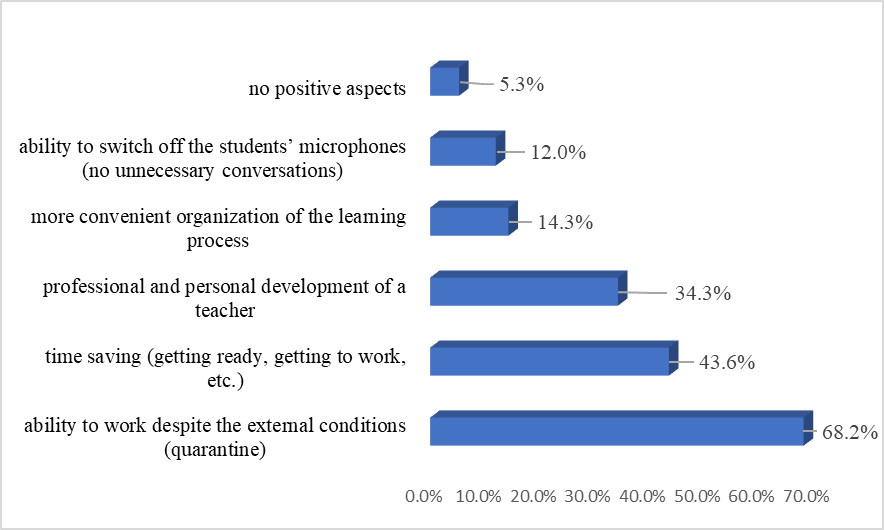
As for the positive aspects of online learning for students, they marked (there was a choice of several answers): the ability to study from anywhere in the world (82%), the ability to combine with other activities (82%), constant access to the learning materials (55%), the availability of online education (53%), and individual approach to learning (14%).
Education using modern computer technologies allows students to become members of special online interest groups, subscribe to electronic journals, quickly conduct researches using databases and digital archives, communicate via email with fellow students and teachers, create blogs, participate in online discussions and provides many other opportunities. Such a wide diversity of activities is unavailable in the context of traditional teaching and learning (Janelli, 2018).
Nonetheless, 5.3% of surveyed teachers did not find any positive aspects in online communication, and when using online educational platforms both teachers and students encountered many problems and difficulties.
Adjustment of classes to online version increases labor expenditures – 70% of respondents agreed with this statement. It is necessary to change the form of presentation of the material, it takes more time to prepare for the class, and, because there is no energy exchange with the students, fatigue from “talking to a wall” is greater. However, university administration usually ignores these circumstances. It does not affect either workload reduction or the salary. If schoolteachers have reduced the time of online lessons, university teachers have to conduct a full-time class, while feeling greater control from the administration (44.5% of respondents noted that the university administration began to control their work more, moreover most of online classes are recorded on video).
The poor quality of the internet connection can be also classified as technological difficulties, this problem was noted by 48.8% of respondents. The internet service providers do not always cope with the load, which has increased due to large amount of people working remotely during self-isolation and line breaks, and internet connection interruptions have become a common situation.
A great number of technical nuances that need to be delved into – this difficulty was highlighted by 43% of teachers. Using a computer for many, especially the older generation, caused difficulties earlier, and in the conditions of universal distance learning they had to deal with everything at once and often without any help from the university.
Mastering educational platforms requires a large amount of time – this was the answer of 40.5% respondents. Furthermore, teachers are annoyed by the functional imperfection of online platforms – 30.8% (not all types of work can be implemented online, many online platforms are very opaque and difficult to master both for teachers and students). Another technical problem that has already been mentioned is that one need constants technical support which is not always available (27.3% of responses). On the positive side 11% of respondents did not have difficulties in mastering online platforms. Moreover, when analyzing the pair distribution by age of respondents the least difficulties arouse for teachers aged from 36 to 45 (47.7%). Most likely it is explained by a combination of good computer and internet technologies skills with teaching experience that allowed the most successful mastering of new resources.
In addition to the difficulties of mastering online platforms there are negative aspects of online education in general which were highlighted by the respondents (Figure
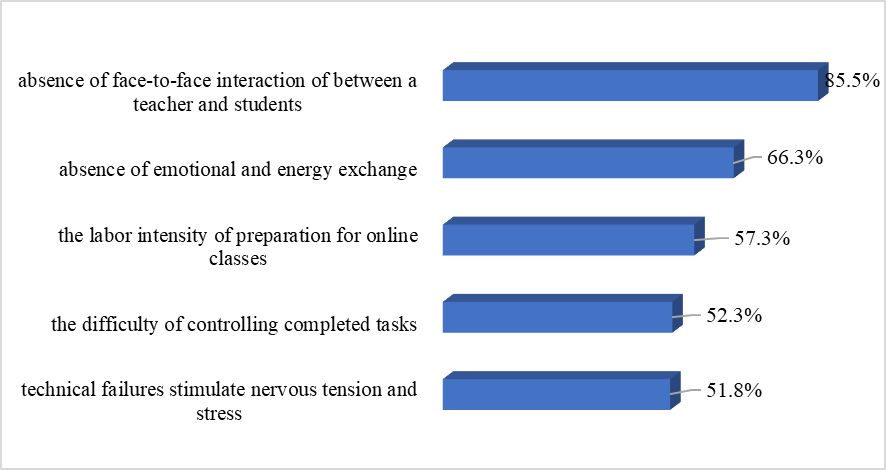
The most negative aspect of online education is the absence of face-to-face interaction between the teacher and the student according to 85.5% of respondents. Mediated interaction between the teacher and the student leads to decrease in the quality of the taught material. Likewise, it affects the degree of collective cooperation tearing and, to a certain extent, traditional social connections that are formed and active only through face-to-face interaction between students and a teacher (Basset, 2020).
The teacher for students has always been not only a repeater of the material, they are inspired by the strength of his personality, charisma, passion, and love for the subject. All these nuances are quite difficult to convey remotely. There is no emotional and energy exchange (66.3%). Teachers in the classroom giving their energy in their turn are charged from the students, there is an exchange of not only knowledge but energy flows as well. Online communication loses out to live communication. An online lesson leaves many feeling tired and powerless.
57.3% of respondents noted the labor intensity of preparation for online classes. The visual content of such a lesson should be greater than that of a classical lesson. It is hard for students to concentrate and just listen to the teacher so the design of presentations, tests, and various materials for online communication require much more time and effort. Likewise, it requires much effort to conduct the online class itself. These conclusions are confirmed by a number of other questions, for example, the question of changes in the workload during distance education (Figure
The workload has increased significantly according to 60.5% of respondents. Another 30% believe that it has increased but not significantly and less than 10% believe that it has not changed (7.5%) or even decreased (3.3%).
The question about teachers’ fatigue continues the topic of increasing workload. 50.9% of respondents are tired more than in the classroom when conducting online classes. Fatigue is comparable to fatigue from face-to-face classes for 41.1% of respondents, the rest (8%) noted that they are less tired. As a result, we can draw a conclusion about the necessity to review the time and efforts of teachers when conduction online classes. The issue of adjusting the workload in the direction of its reduction should be considered by the university administration.
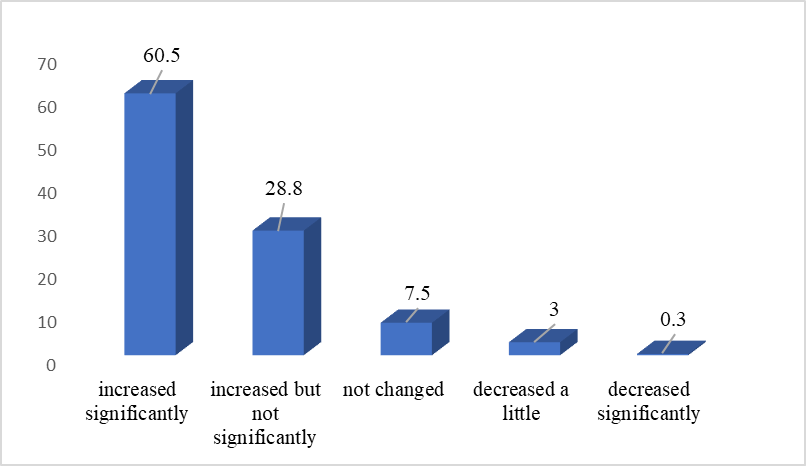
One more problem that teachers had to face was the difficulty of controlling completed tasks (52.3%). Many respondents noted that the task can be given to a group but only 1-2 students do and report it and if it can be tracked during live work, it is almost unrealistic within distance learning. It is also very hard to prevent cheating, even proctoring does not give absolute guarantees.
In addition, the instability of the technical component of online communication is a problem for many teachers. Many respondents (51.8%) noted technical failures that cause nervous tension and stress. Most of the teachers faced the following problems: an internet line break, server crashes, computer failure or its components, incorrect program settings, etc. All this increases emotional tension and increases the feeling of anxiety.
Apart from the mentioned problems which are relevant for the majority of the respondents, other difficulties were formulated. Some are concerned about the overall decline in the quality of online education, others note the lack of necessary self-discipline for online communication among both students and teachers. Parents of minor children have an additional complication connected with the need to combine work from home with the increased in volume household chores: including the upbringing and care for children, and organization of their educational process. Many people are distracted by their family, the respondents noted that working time cannot always be clearly separated from leisure and non-working duties, as a result, work becomes endless. Teachers complain about the increased number of written assignments and the need to check them. There are also a number of specialties which are practical and cannot be taught through online communication: doctors, musicians, chemists, physics, etc. (laboratory work, practical classes, experiments are not available). Teachers are irritated by the constant monitoring of various inspections and increased reporting. Some say their health is getting worse: reduced vision, a large load on the voice, constant stress leads to an aggravation of cardiovascular diseases.
The main disadvantages of online learning in students’ assessments mostly repeat the position of teachers: absence of face-to-face contact with a teacher (68%), difficulty of self-organization (64%), necessity to ensure constant access to the internet (52%), the limitation of the implemented disciplines (33%), broken social connections withing the group (32%).
Comparing the quality of online education with the traditional one according to the university teachers is a rather depressing picture (Figure
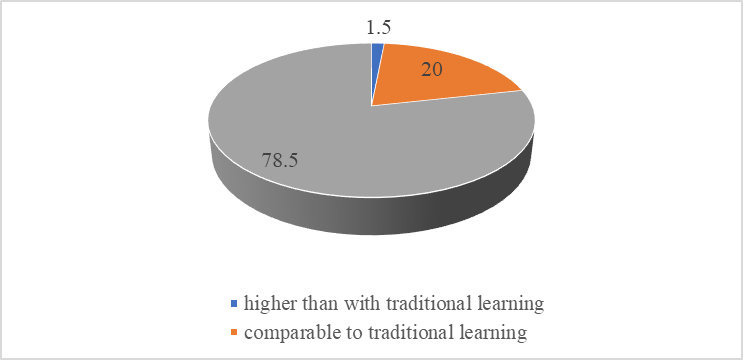
The vast majority of respondents believe that the quality of online education is inferior to the traditional one (78.5%). Indeed, the online communication that has developed in the conditions of self-isolation is extreme and full-fledged online courses that are located on leading platforms (Coursera, “Открытое образование”[opened.ru], etc.) differ in their conceptual and methodological training. However, they also have a low performance of completing a full course. To learn effectively with online courses, one needs to have serious motivation and research shows not many students have it.
In addition, the educational and socializing effect of the higher education is essential. The teacher's personality who can attract, his life experience, worldview is in itself a learning component. Students' interaction with each other, group work, and the ability to distribute responsibilities – soft skills that are so valued by modern employers are not available within online communication. Scientific researches of foreign colleagues confirm this:
So far most methods of online education do not have empirically based opportunities for developing social and emotional skills as it happens with traditional face-to-face education, and it is not aimed at this; this is quite a disturbing fact which, accordingly, should lead to the increased investment in the study of teaching and learning processes (Basset, 2020, p. 11).
An important component of the educational process is the teacher's emotional state, their sense of security and stability. Thus, in assessing their security when conducting online classes, a significant group of respondents (44.5%) chose the position "satisfactory" on a five-point scale. The rest of the respondents were distributed almost evenly in positive and negative sides in the assessment of their own security.
Among the factors that violated teachers' boundaries, caused discomfort and anxiety, certain situations were named. The whole group of students did not enter the announced webinar (the reason could be a technical error or someone's intent) – 21.8% of the respondents faced such a situation. Students did not answer teacher's questions ignoring them - 18.3% noted this option. Students did not enter under their own name and created "duplicates" – 11.5% of respondents answered. One of the most extreme cases is when strangers come to classes and interfere with the learning process (11.3%). For a teacher this situation is as unpleasant as possible and he or she can feel absolutely helpless. In the comments to the survey one teacher wrote there was a case of an exhibitionist entering a webinar which provoked a very stressful situation. It becomes necessary to protect teachers from such interference with technical means and develop mechanisms for psychological compensation as well.
Among the positive emotions when conducting online classes are most mentioned – satisfaction (41% of respondents), enthusiasm (18.8%), excitement (11.5%), and joy (7.8%) which indicates the teacher’s enthusiasm despite everything people love their work and perform it eagerly. Unfortunately, there is also a significant number of negative emotions from the process of online communication: irritation (28%), doom (21.3%), sadness (15.8%), helplessness (14%), and anger (3.5%). 8% of the respondents do not feel any special emotions and perceive online classes as a normal workflow.
When trying to assess the prospects of higher education the majority of respondents (80.7%) agreed that there will be more elements of distance education (Figure
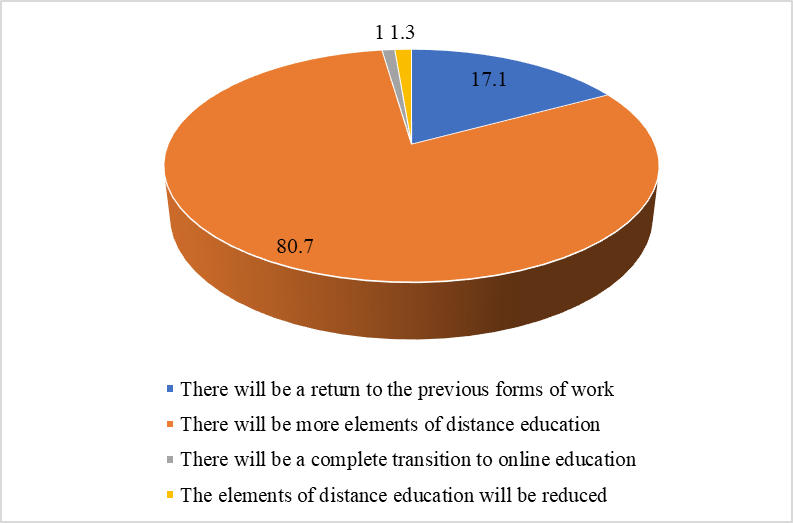
Many teachers hope that there will still be a return to previous conditions and forms of work (17.1%), some even believe that the elements of distance education will be reduced (1.3%). There are also those who predict a complete transition to online education образование (1%). Nonetheless, for most it is obvious that elements of online communication should be included to in everyday practice. However, not everyone is happy with his prospect. When asked if you would like such changes – 45.2% of respondents answered in the negative, 35.5% found it difficult to answer and only 19.3% of respondents were positive about online communication. It is interesting that people of the younger age (under 35) and the oldest age group (over 66) are most positive about these changes. For young people this is most likely due to their enthusiasm to start teaching and their knowledge of modern technologies. Among the older generation there are more managers, heads of departments, who are forced to adapt for existing realities and set the tone for the entire team.
These findings confirm the assessment of modern research. For example, Philip Altbach and Hans de Wit in their article state that the crisis associated with the pandemic will certainly expand prevalence of distance education. But the authors doubt that universities will face a long technological revolution: “yet, for many reasons – community, prestige, teaching networking and learning advantages, among others – students and academics will continue to prefer face-to-face higher education” (Altbach & De Wit, 2020, p. 5).
Conclusion
As a result, we can say that online communication in higher education certainly has its future. Its capabilities include the development of new technical skills by teachers and students, the development of professional and personal qualities of teachers, constant self-development, new horizons for the implementation of the creative process of education, the ability to engage experts even from other countries, the mass character and accessibility of higher education.
The value of the modern experiment in the pandemic situation is that it not only helps to fill the gaps that have arisen due to the closure of universities, but it also allows to try new pedagogical ideas, methods, and tools. For example, online communication allows universities to reach a wider audience regardless of the student’s location. Being in different places far from each other teachers and students can still interact. The training ground is no longer limited to one institute (Dunjun & Jin, 2020).
Although there are many limitations and nuances of online communication in higher education that do not allow to consider it a panacea. One of the first problems is that students are representatives of a new generation working in a completely different way, already possessing digital thinking. And teachers are mainly representatives of the old generation who are forced to adapt to the digital environment. Therefore, there is a conflict in learning: globalization against localization (Usacheva & Chernyakov, 2020).
A sense of security, which they are still deprived of for many reasons and especially when communicating online, is valuable for teachers.
Furthermore, the main drawback of online communication is the lack of face-to-face contact between the teacher and the student and students, the absence of the energy exchange, and the inability to develop social and emotional competencies. The teacher's personality, charisma, and life experience are very difficult to convey online, which is the most valuable in the educational process.
Besides, one of the disadvantages of modern online communication is the duplication of traditional teaching methods in online, while a new channel for transmitting information requires a new approach.
For example, many western universities today consider students as partners or co-authors in the learning process: they provide them with the opportunity to participate in the management of the university or the formation of the curriculum; implement mutual learning programs, or conduct classes that stimulate student activity. In most universities, these classes are held in a mixed format combining online and face-to-face teaching methods. These pedagogical practices are developed and taken into consideration by the teachers who are ready to reconsider their role in the educational process and become intermediaries and assistance in learning renounce the status of a monopoly owner of knowledge (Young, 2018).
References
- Altbach, Ph. G., & De Wit, H. (2020). Post pandemic outlook for higher education is bleakest for the poorest. International Higher Education, 102, 6-8.
- Amemado, D. (2020). COVID-19: an unexpected and unusual driver to online. International Higher Education, 102, 14-16.
- Basset, R. M. (2020). Preserving the values of higher education in the context of the COVID-19 pandemic. International Higher Education, 102, 9-11.
- Bystrova, T., Larionova, V., Sinitsyn, E., & Tolmachev, A. (2018). Learning Analytics in Massive Open Online Courses as a Tool for Predicting Learner Performance. Educational Studies Moscow, 4, 139–166.
- Dunjun, B., & Jin, L. (2020). Temporary measures or a new experimental model? Teaching in Chinese universities during the COVID-19 pandemic. International Higher Education, 102, 19-21.
- Janelli, M. (2018). E-Learning in Theory, Practice, and Research. Educational Studies Moscow, 4, 81–98.
- Keyek-Franssen, D. (2018). Practices for Student Success: From Face-to-Face to At-Scale and Back. Educational Studies Moscow, 4, 116–138.
- Larionova, V., & Tretyakov, V. (2016). Otkrytyye onlayn-kursy kak instrument modernizatsii obrazovatel'noy deyatel'nosti v vuze [Open online courses as a tool for modernization of educational process in universities]. Higher Education in Russia, 7, 55–66.
- Roshchina, Ya., Roshchin, S., & Rudakov, V. (2018). Spros na massovyye otkrytyye onlayn-kursy (MOOC): opyt rossiyskogo obrazovaniya [Demand for massive open online courses (MOOC): evidence from Russian education]. Educational Studies Moscow, 1, 174–199.
- Semenova, T., Vilkova, K., & Shcheglova, I. (2018). Rynok massovykh otkrytykh onlayn-kursov: perspektivy dlya Rossii [The MOOC market: prospects for Russia]. Educational Studies Moscow, 2, 173–197.
- Serditova, N., & Belotserkovskii, A. (2020). Obrazovaniye, kachestvo i tsifrovaya transformatsiya [Education, quality and the digital transformation]. Higher Education in Russia, 4, 9-15.
- Usacheva, O., & Chernyakov, M. (2020). Otsenka gotovnosti vuzov k perekhodu k tsifrovoy obrazovatel'noy srede [Assessment of university willingness to the transition to digital educational environment]. Higher Education in Russia, 5, 53–62.
- Young, S., (2018). From Disruption to Innovation: Thoughts on the Future of MOOCs. Educational Studies Moscow, 4, 21–43.
- Zakharova, U. (2019). MOOK v vysshem obrazovanii: dostoinstva i nedostatki dlya prepodavateley [MOOCs in higher education: advantages and pitfalls for instructors]. Educational Studies Moscow, 3, 176-202..
Copyright information

This work is licensed under a Creative Commons Attribution-NonCommercial-NoDerivatives 4.0 International License.
About this article
Publication Date
16 April 2021
Article Doi
eBook ISBN
978-1-80296-104-1
Publisher
European Publisher
Volume
105
Print ISBN (optional)
-
Edition Number
1st Edition
Pages
1-1250
Subjects
Sustainable Development, Socio-Economic Systems, Competitiveness, Economy of Region, Human Development
Cite this article as:
Cherkasova, V., & Kopalova, O. (2021). Opportunities And Restrictions Of Online Communication In Higher Educational System. In E. Popov, V. Barkhatov, V. D. Pham, & D. Pletnev (Eds.), Competitiveness and the Development of Socio-Economic Systems, vol 105. European Proceedings of Social and Behavioural Sciences (pp. 848-859). European Publisher. https://doi.org/10.15405/epsbs.2021.04.90

